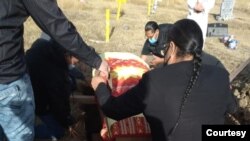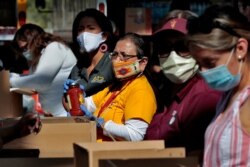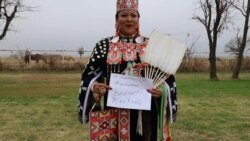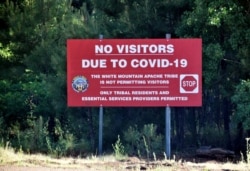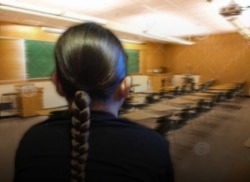“How many friends have I lost to COVID?”
Craig Falcon, a member of the Blackfeet Nation in Montana, counts out loud:
“One … three … seven … nine in the last two months,” he said. They were close friends, he said, almost like brothers.
“One friend? The last time we talked on the phone, we were going, ‘Good morning, how’re you doing?’ At the time, he was asymptomatic. Then two days later? He's dead,” Falcon said.
He’s not alone in grieving. VOA spoke or messaged with citizens of several tribes across the country. Everyone said they knew at least one person who had died, sometimes several in a single household.
Increased risk
American Indians/Alaska Natives (AI/AN) people have disproportionately high rates of many health conditions that increase their vulnerability to coronavirus, including diabetes, heart and lung disease, asthma, and obesity.
The U.S. Centers for Disease Control reports that in the 14 states studied, American Indians/Alaska Natives died at nearly twice the rate of white Americans during the first half of 2020. The study also suggests these figures may be conservative, as testing is limited in some areas and some AI/ANs are reluctant to get tested.
Stephanie Hebert, First Nations Miꞌkmaq from Nova Scotia, Canada, is one of the co-founders of the Social Distance Pow Wow (SDPW) Facebook page, created in mid-March after the COVID-19 pandemic forced thousands of pow wows to be canceled—generating huge disappointment among tribes.
“Pow wow is not a casual shindig. It's a way of life for many. It’s where they make their income, whether winning money in dance contests or selling their wares,” she said.
The SDPW gave dancers, drums and vendors a place to post performance videos and market crafts.
Nowadays, however, the posts are grim.
"Humbly asking for prayers as we lost our niece last night. She was a vibrant, young lady that had a lot to live for. She leaves behind 3 little ones ages 9, 8 and 3. Without their mother, they'll be so lost," reads a recent message.
“We're getting flooded with prayer requests because people are losing their loved ones left and right,” said Hebert. “The virus has just ground everyone to dust.”
Fear, stress, isolation
The situation in South Dakota is particularly dire.
Mariella Anderson, a member of the Cheyenne River Tribe now living in Rapid City, South Dakota, told VOA that it was her teenager who brought COVID home to the family. She asked VOA not to use her real name for fear of embarrassing her son.
“My son sneaked out with these kids to a party on a Saturday night,” Anderson said. “Then on Monday, he woke up and said, ‘Mom I don't feel too good.’ At first, I thought he was playing around, but he wasn’t."
Anderson said it wasn’t long before everyone in the house came down with COVID—including her elderly mother, Kate, who passed away soon afterward in a Rapid City hospital.
“I tell my son, ‘Don't blame yourself. Grandmother was old. She had an underlying health issue,’” she said, adding, “Because I don't want my son to be suicidal.”
Youth suicide has always been a concern on South Dakota reservations. The pandemic has only made matters worse.
“Since April this year, we've had 21 suicides, mostly youth,” said Yvonne “Tiny” DeCory,” director of the BEAR Project, a youth and suicide nonprofit on the Pine Ridge Indian Reservation.
Pine Ridge encompasses some of the poorest counties in America. Before COVID, unemployment ran nearly 90 percent, and more than half its families lived below the poverty line.
Today, many of those who do have jobs have been furloughed. Some are having a hard time putting food on the table.
This year, the tribe canceled its summer youth work program.
“These jobs put young people to work for four hours a day,” said DeCory. “They look forward to those summer jobs so they can buy a pair of nice sneakers or some jeans to wear to school in the fall.”
Schools did not reopen this year, which means youth are isolated from friends and community. Many students struggle with distance learning.
“Some of our children don’t have computers or internet access,” said DeCory, “and they are freaking out because they don’t want to fail.”
Fear, stress and isolation cause some to turn to drug and alcohol use, and these can lead to violence.
“It’s so easy for them to go to a bootlegger and buy a ‘water bottle’ and get drunk as a skunk,” DeCory said.
Measures in place
South Dakota’s COVID-19 cases began to climb in September. Several South Dakota tribe members said they link the surge to a 10-day motorcycle rally, which brought more than 365,000 people to the town of Sturgis in early August. San Diego State University’s Center for Health Economics and Policy Studies released a report in September linking more than 260,000 coronavirus cases.
South Dakota Gov. Kristi Noem, who has refused to mandate the wearing of masks, rejected the study as “fiction.”
For now, tribes are imposing their own restrictions, ranging from blockades, lock-downs or stay-at-home orders, and making masks mandatory.




